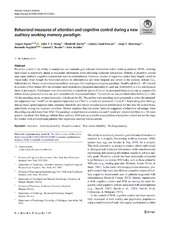| dc.contributor.author | Kayser, Jurgen | |
| dc.contributor.author | Wong, Lidia Y X | |
| dc.contributor.author | Sacchi, Elizabeth | |
| dc.contributor.author | Casal-Roscum, Lindsey | |
| dc.contributor.author | Alvarenga, Jorge E | |
| dc.contributor.author | Hugdahl, Kenneth | |
| dc.contributor.author | Bruder, Gerard E | |
| dc.contributor.author | Jonides, John | |
| dc.date.accessioned | 2020-05-19T16:17:51Z | |
| dc.date.available | 2020-05-19T16:17:51Z | |
| dc.date.issued | 2019-12-03 | |
| dc.Published | Kayser, Wong, Sacchi, Casal-Roscum, Alvarenga, Hugdahl K, Bruder, Jonides. Behavioral measures of attention and cognitive control during a new auditory working memory paradigm. Behavior Research Methods. 2019 | eng |
| dc.identifier.issn | 1554-351X | |
| dc.identifier.issn | 1554-3528 | |
| dc.identifier.uri | https://hdl.handle.net/1956/22309 | |
| dc.description.abstract | Proactive control is the ability to manipulate and maintain goal-relevant information within working memory (WM), allowing individuals to selectively attend to important information while inhibiting irrelevant distractions. Deficits in proactive control may cause multiple cognitive impairments seen in schizophrenia. However, studies of cognitive control have largely relied on visual tasks, even though the functional deficits in schizophrenia are more frequent and severe in the auditory domain (i.e., hallucinations). Hence, we developed an auditory analogue of a visual ignore/suppress paradigm. Healthy adults (N = 40) listened to a series of four letters (600-ms stimulus onset asynchrony) presented alternately to each ear, followed by a 3.2-s maintenance interval and a probe. Participants were directed either to selectively ignore (I) the to-be-presented letters at one ear, to suppress (S) letters already presented to one ear, or to remember (R) all presented letters. The critical cue was provided either before (I) or after (S) the encoding series, or simultaneously with the probe (R). The probes were encoding items presented to either the attended/not suppressed ear (“valid”) or the ignored/suppressed ear (“lure”), or were not presented (“control”). Replicating prior findings during visual ignore/suppress tasks, response sensitivity and latency revealed poorer performance for lure than for control trials, particularly during the suppress condition. Shorter suppress than remember latencies suggested a behavioral advantage when discarding encoded items from WM. The paradigm-related internal consistencies and 1-week test–retest reliabilities (n = 38) were good to excellent. Our findings validate these auditory WM tasks as a reliable manipulation of proactive control and set the stage for studies with schizophrenia patients who experience auditory hallucinations. | en_US |
| dc.language.iso | eng | eng |
| dc.publisher | Springer Nature | eng |
| dc.rights | Attribution CC BY | eng |
| dc.rights.uri | http://creativecommons.org/licenses/by/4.0/ | eng |
| dc.subject | Attention | eng |
| dc.subject | Auditory modality | eng |
| dc.subject | Proactive control | eng |
| dc.subject | Test–retest reliability | eng |
| dc.subject | Working memory | eng |
| dc.title | Behavioral measures of attention and cognitive control during a new auditory working memory paradigm | eng |
| dc.type | Peer reviewed | |
| dc.type | Journal article | |
| dc.date.updated | 2020-02-07T09:13:39Z | |
| dc.description.version | publishedVersion | |
| dc.rights.holder | Copyright 2019 The Author(s) | eng |
| dc.identifier.doi | https://doi.org/10.3758/s13428-019-01308-z | |
| dc.identifier.cristin | 1775036 | |
| dc.source.journal | Behavior Research Methods | |

